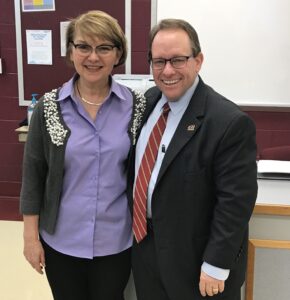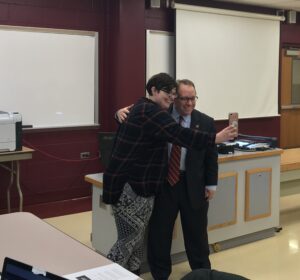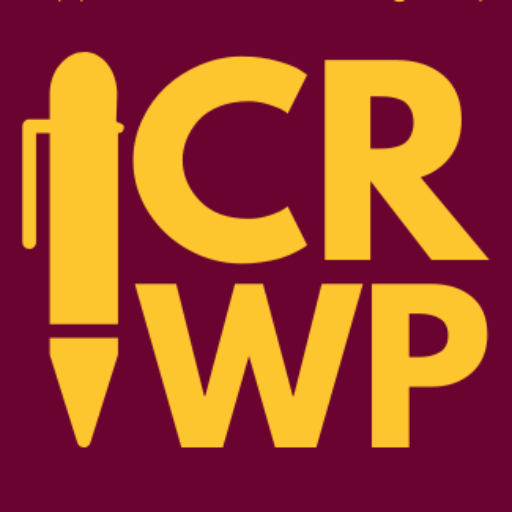On November 30, 2018, President Davies accepted an invitation to the final exam session of ENG 319: Composition Methods at Central Michigan University. The purpose of the visit was to talk about the urgent message he had sent to the university community the morning after a hate crime took place on campus. ENG 319 students, who are all pre-service English teachers, had shared their written feedback regarding the message with the president, and they were eager to hear his remarks. See Part I of “He Said, ‘Yes’” for a full explanation of the background leading up to the visit, and see PQP for a description of the adapted NWP protocol that ENG 319 students used to provide feedback.

Just as ENG 319 students hoped, President Davies began our time together by providing writerly context for his urgent message and a few “behind the scenes” facts that the general public didn’t know: how he first learned of the hate crime (while driving to Midland to meet a university donor), how the writing process began (on his cell phone en route to Midland, with frequent pullovers to ensure safety), and how many drafts the message required (more than ten, in intense consultation with his administrative team). Students also learned that, in crafting the message, President Davies intentionally chose to send a single, unified message to the entire university community, rather than write adapted messages for different campus groups—a noteworthy writerly choice, from my students’ perspective. After all, English majors know that effective writers typically adapt texts to meet the specific needs of audience members. As a result, the president’s standard composing process made concrete this rhetorical value, even as it was rendered more complex and nuanced by his choices for the November 8 message. In addition, President Davies knew the message had to come from him personally, not a designee. He wanted audience members to hear his voice.

President Davies placed special emphasis on the need to create a “concise and to the point” message, which explains why his statement consists of only thirteen sentences. The child of an American history professor, President Davies reminded ENG 319 students that two speeches were delivered at Gettysburg Cemetary on November 19, 1863. In the first speech, now long forgotten, the speaker droned on for literally hours, but the second speech–Lincoln’s Gettysburg Address, comprised of only 271 words–will always be remembered. For his November 8 message, President Davies wanted every word to count. His goal was to condemn the hate crime in no uncertain terms, to apologize and reassure the targeted victims and everyone else in the university community affected by the crime, and to make a solemn pledge, that he and CMU will stand up against “racism, misogyny, bigotry, and hatred” in any form. “We must do better. We must lead. We will lead.” President Davies’ characterization of his writing process and product perfectly demonstrated the writerly importance of purpose, audience, and writerly ethos, and feedback from ENG 319 students provides evidence that the message, as a whole, achieved its purpose:
Thank you for your response to a racist and hateful action that took place on campus. You clearly state that this is not tolerated in our community and that, as a community, we must all stand against this behavior. I particularly like the part where you reached out to the three students affected and said they belong here … The end is a great call to action: short, memorable, and decisive. Brooke Boeneman, Flint Senior
Thank you for emailing the Central Michigan University student body and staff about the hateful remarks written in one of the residence hall rooms. I think you did a great job of informing campus by identifying the problem without giving attention to the people who wrote the messages and by illustrating how it affects the student body, faculty, and community. Kayla Smith, Remus Senior
Thank you for releasing your November 8 statement combating the racist event that took place in Sweeny Hall at CMU. It demonstrates that you are genuinely passionate about ensuring that CMU takes steps forward regarding diversity, equality, and respect … Overall, your message seemed heartfelt and honest. You did a fantastic job ensuring students know that racism is against all CMU policies/values, and that the University stands with the victims. Collin Hoeberling, Dewitt Senior
Thank you for your thoughtful letter to reassure students that racism, misogyny and other forms of attacks on people of marginalized identities are not tolerated here at CMU. You were very firm with your position, and it was wonderful that you responded so quickly to the incident – it shows you care about students … I’m glad that you specifically told the three students that they were valued members of the community. I understand their desire to remain anonymous, but I think it was excellent that you still publicly spoke in defense of them. Nick Kisse, West Bloomfield Senior
In addition to valuing the president’s message, as a whole, students indicated that specific passages and rhetorical elements particularly resonated with them, as the following feedback attests:
I liked that you called this act by its name(s): racism, misogyny, and bigotry … I want to commend you for finishing this powerful message with a call to action. It really hits home that you know changes need to be made and we, as a community, MUST make them. It puts the blame/solution on us. Amanda Miiller, New Baltimore Senior
I appreciate how you use the CMU values to authorize your stance on hateful actions, like the Sweeney Hall Incident. Your discussion of our University’s values and mission shows that hateful words and actions have no place on our campus. Madi McEachern, Holly Senior
I am glad you called for CMU to come together against this act, reinforcing our need for community. Holly English, Bay City Senior
The most moving part of your response was paragraph three. In that paragraph, you devoted all of your attention making it clear that the three targeted students are bright, talented, and welcome at CMU. It made me feel more connected to them, more connected to my outraged peers, and more connected to the unity of this campus as a whole. Wyatt Crick, East Jordan Senior
As a final note, I’m glad you took the time to put a variety of resources available to students along with this letter. As an RA, I know it frequently happens that someone preaches to utilize campus resources while not providing what those resources are. I’m certain you taking that extra step has helped many students, and I was happily surprised to see it there. Andrew Keith, Okemos Senior
And there were thoughtful questions too:
I do have one question: what are the steps that are being taken ()r have been done] to resolve this crime? We understand that lots of different groups and people are working on this case, but there has been no follow up to know specifics on what is being done to resolve the issue that I am aware of. Madi Cole, Wayland Senior
What I’d like to know is what can we, the average students here at CMU, do to help? What can we do to extinguish this hatred? So many student seem to be talking a lot about what happened, but talk alone is not enough. What can we do so that you, or any other CMU president down line, never has to send another letter like you did? Jonathon Skinner, Cadillac Senior
Why haven’t we received a follow-up letter? Is there one coming soon? Macey Hodge, Kentwood Senior
Overall, I thought the message was effective and encouraging because of its effort to communicate that CMU is a safe place. My question is, how are you, as the president of the university, going to ensure that this is the reality? What precautions have/are you going to take to ensure that something like this doesn’t happen again? Kayla Taylor, Midland Senior
The president indicated that the privacy and safety of the targeted students continue to be his primary goal. In fact, shortly after the incident, the president respectfully requested a private conversation with the three women to be held in Sweeney Hall (not his presidential suite in Warriner Hall), where he could hear their stories and offer his heartfelt apologies for the heinous crime on behalf of his office and the entire university community. Further, he reported that, as the 2018-19 year progresses, he continues to check in with these three women and their families for ongoing support. President Davies also shared that the three women requested a private meeting with the reporting officer who, in trying to console them the night of the hate crime, inadvertently made racially insensitive comments. Having debriefed with both the three women and the officer in question, President Davies came away highly satisfied with the outcome of this informal meeting, which he believed had a greater and long-lasting impact than a mandatory workshop or seminar ever could, as important as they can be. The president also indicated that, to date, he had no developments to report regarding the ongoing investigation, but he did point out that security cameras in each of the dorm hallways would have immediately resolved the investigation. However, he asked if CMU students really wanted the university tracking and documenting their “comings and goings” in the residence halls–a good question for a group of pre-service English teachers well versed in dystopian literature, including George Orwell’s 1984 and its ever-watchful presence: Big Brother. Equally important, the president’s question contextualized ordinary daily life at CMU in the larger national debate over the competing values of privacy vs. safety.

Like most conversations about writing, the president’s and students’ comments ranged from the global and document level (context, purpose, audience, tone, and writing process) to the sentence and word-level. In the case of word- and sentence-level considerations, several students commended the president for his pronoun choice, which is first person singular in the beginning of the message and first-person plural at the end–an intentional choice on the president’s part. Later, there was good-natured laughing over the so-called Oxford comma–a running joke in ENG 319 all semester, now that the comma is no longer considered “optional” in both APA and MLA documentation style. Here, the students learned that President Davies, to date, “holds an aversion” to the Oxford comma, so he chooses to flout the rule and purposefully ignores the convention. In response, I shared “my loathing” of the new MLA rule that requires a single space after a period at the end of a sentence (instead of two spaces). And speaking of word- and sentence-level considerations, one student–Collin Hoeberling–asked President Davies if he would change anything in the message, if he had the opportunity to write it over again. After a long and thoughtful pause, the president indicated that he wished he had added a single word, “transphobia,” to the list of atrocities that would not be tolerated at CMU. Significantly, a close reading of the president’s “Welcome Back” message on January 8, 2019 reveals the writerly impact of the student’s query because the word, “transphobia,” is included in the conclusion. Note: At a later event, the president told me that he had, in fact, referred to his notes regarding the ENG 319 final exam session as part of his writing process for the January 8 message.

After the president donned his topcoat and signature fedora, thanked the group for the opportunity, and left Anspach Hall, room 253, ENG 319 students exploded with enthusiasm. Initially, they raved about President Davies as a person: so down to earth … very genuine and authentic … a great listener … And of course the inevitable: Can you believe he let us take selfies with him? But then the conversation shifted in a direction more in keeping with President Davies’ class visit: his writing. More specifically, students reflected upon how important and complicated it would be to write in the role of a university president. The sheer number of audience members/groups. The enormous range of responsibilities and related skill sets required. The many hats a president must wear. During the best of times, writing under these circumstances would be challenging, but what about during a time of crisis, such as the November 2018 incident? During the “best and worst of times,” though, students agreed that President Davies would be highly thoughtful and intentional in his writing, both in terms of writing process (planning, drafting, and ESPECIALLY revising) and product — a great lesson for all pre-service English teachers.

These final sentiments regarding President Davies were perfectly summed up by one student–Holly English–whose words inspired the title of this blog series. She said that President Davies is not merely a president who writes; he is “a president who is a writer.”
Elizabeth Brockman is a founding co-director of the Chippewa River Writing Project. A former middle and high school English teacher, Elizabeth is currently a professor in the English Department at CMU, where she teaches composition and composition methods courses.

This work is licensed under a Creative Commons Attribution-NonCommercial-ShareAlike 4.0 International License.


Leave a Reply
You must be logged in to post a comment.